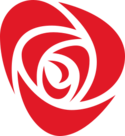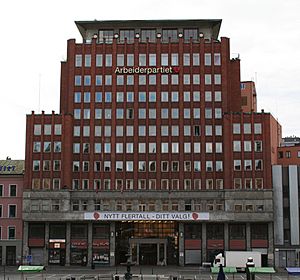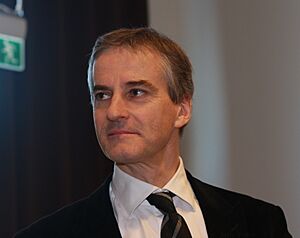Labour Party (Norway) facts for kids
Quick facts for kids
Labour Party
Arbeiderpartiet
Arbeidarpartiet |
|
|---|---|
 |
|
| Abbreviation | A Ap |
| Leader | Jonas Gahr Støre |
| Parliamentary leader | Bjørnar Skjæran |
| Founded | 22 August 1887 |
| Headquarters | Youngstorget 2 A, 5th floor, Oslo |
| Youth wing | Workers' Youth League |
| Membership (2024) | |
| Ideology | Social democracy Pro-Europeanism |
| Political position | Centre-left |
| European affiliation | Party of European Socialists |
| International affiliation | Progressive Alliance Socialist International (1951-2016) |
| Nordic affiliation | SAMAK The Social Democratic Group |
| Colours | Red |
| Slogan | Trygghet for fremtiden ('Safety for the future') |
| Storting |
48 / 169
|
| County councils |
277 / 777
|
| Municipal councils |
2,023 / 10,620
|
| Sámi Parliament |
7 / 39
|
The Labour Party (also known as Arbeiderpartiet in Norwegian) is a major political party in Norway. It is often called A or Ap for short. This party is known for its social democratic ideas, which means it believes in a fair society where everyone has equal chances. It is positioned on the centre-left side of politics. The current leader of the Labour Party is Jonas Gahr Støre.
The Labour Party was the main party in a government with the Centre Party from 2021 until the Centre Party left the government in 2025. Jonas Gahr Støre has been the Prime Minister of Norway since October 2021. The party's main goal is to create a strong welfare state. This means the government helps people with things like healthcare, education, and social support. They believe this should be paid for through taxes.
Since the 1980s, the party has also included some ideas from a social market economy. This means they allow some private businesses and services, and they have changed tax rules. The Labour Party supports Norway being part of NATO. They also supported Norway joining the European Union in past votes. The party's youth group is called the Workers' Youth League.
Contents
History of the Labour Party
The Labour Party was started in 1887. It slowly gained more support over the years. By the 1927 election, it became the biggest party in Norway. It has held this position ever since.
How the Party Started

The party began in 1887 in a town called Arendal. It first took part in elections for the Storting (the Norwegian Parliament) in 1894. The party won its first seats in parliament in 1903. Its support grew steadily until 1927, when it became the largest party. For a few years, between 1918 and 1923, the party was part of a communist group called the Communist International (Comintern).
The Labour Party had many newspapers and other ways to share its ideas. This included Vort Arbeide and later Norsk Arbeiderpresse. In 1913, the party had 24 newspapers, and more were started that year. They also had their own publishing house for books and magazines.
The party faced some disagreements in the 1920s. In 1921, some members left to form the Social Democratic Labour Party of Norway. In 1923, the Labour Party left the Comintern. Then, some members left to form the Communist Party of Norway. However, in 1927, the Social Democrats rejoined the Labour Party. That same year, Helga Karlsen became the first woman from the Labour Party to be a Member of Parliament.
In 1928, Christopher Hornsrud formed the Labour Party's first government. But it only lasted for two weeks. In the early 1930s, the Labour Party changed its approach. It became more focused on making changes through laws and reforms. The party returned to government in 1935 and stayed in power through World War II. When Nazi Germany invaded Norway in 1940, the Labour-led government and the royal family moved to London. They led the country from there during the war.
After World War II
After World War II ended, the Labour Party won the 1945 Norwegian parliamentary election. They gained a clear majority of seats in the Storting for the first time. Einar Gerhardsen became prime minister and was a very important leader for Norway after the war. He is often called Landsfaderen, meaning "Father of the Nation". He helped rebuild Norway after the war. The time from 1945 to 1961 is seen as a very strong period for the Labour Party. They kept their majority in parliament until the 1961 election.
In 1963, the Labour government had to step down for a short time. This was due to an event called the Kings Bay Affair. But they returned to power less than a month later and stayed in office until 1965. The Labour Party also led the government during other periods, including 1971–1972, 1973–1981, 1986–1989, and 1990–1997. Important Labour prime ministers during this time included Oscar Torp, Trygve Bratteli, and Gro Harlem Brundtland. The party remained the largest in Norway throughout the rest of the 20th century.
The 21st Century
In 2000, the Labour Party returned to power with Jens Stoltenberg as prime minister. However, after some internal disagreements and a difficult time in government, the party had its lowest election result since 1924 in the 2001 Norwegian parliamentary election. They received only 24.3% of the votes.
The party then went into opposition. But they recovered in the 2005 Norwegian parliamentary election, getting 32.7% of the votes. The Labour Party then formed a government with the Socialist Left and Centre parties. This was called the Red-green coalition.
In 2011, the party officially changed its name from "The Norwegian Labour Party" to simply "The Labour Party". This was to make it clearer for voters. On July 22, 2011, a tragic attack occurred at the Labour Party's youth camp and a government building in Oslo, causing many deaths. Jens Stoltenberg's response to this event was well-received by the public. He spoke about the importance of openness and tolerance.
In the 2013 Norwegian parliamentary election, the Red-green coalition lost its majority. The Labour Party remained the largest party, but they went into opposition. Jens Stoltenberg stepped down as party leader in 2014. Jonas Gahr Støre, who was a well-known figure in Stoltenberg's government, became the new party leader on June 14, 2014. In the 2017 Norwegian parliamentary election, the Labour Party lost more seats. The Conservative Party and its partners stayed in power.
In 2021, the Labour Party returned to government after eight years in opposition. This happened after the 2021 Norwegian parliamentary election. Even though the party lost one seat, the centre-left parties together won a clear majority. Jonas Gahr Støre became the prime minister on October 14, 2021. He led a government with the Centre Party. Soon after, the government faced challenges like the Russian invasion of Ukraine and rising energy prices.
How the Labour Party Works
The Labour Party is organized into local groups across Norway. There are about 2,500 of these groups. The party has a long history of working closely with the Norwegian Confederation of Trade Unions (LO). In the past, members of LO were also automatically members of the Labour Party. This rule changed in 1995.
The highest decision-making body of the party is the Party Congress. This meeting happens every two years. Between these congresses, the National Delegate's Meeting makes important decisions. This group includes the party's Executive Board and two representatives from each of Norway's counties. The Executive Board has 16 elected members and the party leaders.
The party is led by one main leader. It also has one or two deputy leaders. As of 2022, Jonas Gahr Støre is the leader, and Bjørnar Selnes Skjæran is the deputy leader. The party's youth group is the Workers' Youth League. There is also a women's group called the Labour Party Women's Network. The party also takes part in elections for the Sami Parliament of Norway.
Important Labour Party Leaders
Party Leaders

- Anders Andersen (1887–1888)
- Hans G. Jensen (1888–1889)
- Christian Holtermann Knudsen (1889–1890)
- Carl Jeppesen (1890–1892)
- Ole Georg Gjøsteen (1892–1893)
- Gustav A. Olsen-Berg (1893–1894)
- Carl Jeppesen (1894–1897)
- Ludvig Meyer (1897–1900)
- Christian Holtermann Knudsen (1900–1903)
- Christopher Hornsrud (1903–1906)
- Oscar Nissen (1906–1911)
- Christian Holtermann Knudsen (1911–1918)
- Kyrre Grepp (1918–1922)
- Emil Stang (1922–1923)
- Oscar Torp (1923–1945)
- Einar Gerhardsen (1945–1965)
- Trygve Bratteli (1965–1975)
- Reiulf Steen (1975–1981)
- Gro Harlem Brundtland (1981–1992)
- Thorbjørn Jagland (1992–2002)
- Jens Stoltenberg (2002–2014)
- Jonas Gahr Støre (2014–present)
Labour Party Prime Ministers
- Christopher Hornsrud (January–February 1928)
- Johan Nygaardsvold (1935–1945)
- Einar Gerhardsen (1945–1951)
- Oscar Torp (1951–1955)
- Einar Gerhardsen (1955–1963), (1963–1965)
- Trygve Bratteli (1971–1972, 1973–1976)
- Odvar Nordli (1976–1981)
- Gro Harlem Brundtland (February–October 1981, 1986–1989, 1990–1996)
- Thorbjørn Jagland (1996–1997)
- Jens Stoltenberg (2000–2001, 2005–2013)
- Jonas Gahr Støre (2021–present)
Election Results
Storting Election Results
| Election | Leader | Votes | % | Seats | +/– | Position | Status |
|---|---|---|---|---|---|---|---|
| 1894 | Carl Jeppesen | 520 | 0.3 |
0 / 114
|
New | No seats | |
| 1897 | Ludvig Meyer | 947 | 0.6 |
0 / 114
|
No seats | ||
| 1900 | Christian Knudsen | 7,013 | 3.0 |
0 / 114
|
No seats | ||
| 1903 | Christopher Hornsrud | 22,948 | 9.7 |
5 / 117
|
Opposition | ||
| 1906 | Oscar Nissen | 43,134 | 15.9 |
10 / 123
|
Opposition | ||
| 1909 | 91,268 | 21.5 |
11 / 123
|
Opposition | |||
| 1912 | Christian Knudsen | 128,455 | 26.2 |
23 / 123
|
Opposition | ||
| 1915 | 198,111 | 32.0 |
19 / 123
|
Opposition | |||
| 1918 | Kyrre Grepp | 209,560 | 31.6 |
18 / 123
|
Opposition | ||
| 1921 | 192,616 | 21.3 |
29 / 150
|
Opposition | |||
| 1924 | Oscar Torp | 179,567 | 18.4 |
24 / 150
|
Opposition | ||
| 1927 | 368,106 | 36.8 |
59 / 150
|
Opposition (1927–1928) | |||
| Minority (1928) | |||||||
| Opposition (1928–1930) | |||||||
| 1930 | 374,854 | 31.4 |
47 / 150
|
Opposition | |||
| 1933 | 500,526 | 40.1 |
69 / 150
|
Opposition (1933–1935) | |||
| Minority (1935–1936) | |||||||
| 1936 | 618,616 | 42.5 |
70 / 150
|
Majority | |||
| 1945 | Einar Gerhardsen | 609,348 | 41.0 |
76 / 150
|
Coalition (1945) | ||
| Majority (1945–1949) | |||||||
| 1949 | 803,471 | 45.7 |
85 / 150
|
Majority | |||
| 1953 | 830,448 | 46.7 |
77 / 150
|
Majority | |||
| 1957 | 865,675 | 48.3 |
78 / 150
|
Majority | |||
| 1961 | 860,526 | 46.8 |
74 / 150
|
Minority (1961–1963) | |||
| Opposition (1963) | |||||||
| Minority (1963–1965) | |||||||
| 1965 | 883,320 | 43.1 |
68 / 150
|
Opposition | |||
| 1969 | Trygve Bratteli | 1,004,348 | 46.5 |
74 / 150
|
Opposition (1969–1971) | ||
| Minority (1971–1972) | |||||||
| Opposition (1972–1973) | |||||||
| 1973 | 759,499 | 35.3 |
62 / 155
|
Minority | |||
| 1977 | Reiulf Steen | 972,434 | 42.3 |
76 / 155
|
Minority | ||
| 1981 | Gro Harlem Brundtland | 914,749 | 37.1 |
65 / 155
|
Opposition | ||
| 1985 | 1,061,712 | 40.8 |
71 / 157
|
Opposition (1985–1986) | |||
| Minority (1986–1989) | |||||||
| 1989 | 907,393 | 34.3 |
63 / 165
|
Opposition (1989–1990) | |||
| Minority (1990–1993) | |||||||
| 1993 | Thorbjørn Jagland | 908,724 | 36.9 |
67 / 165
|
Minority | ||
| 1997 | 904,362 | 35.0 |
65 / 165
|
Opposition (1997–2000) | |||
| Minority (2000–2001) | |||||||
| 2001 | 612,632 | 24.3 |
43 / 165
|
Opposition | |||
| 2005 | Jens Stoltenberg | 862,456 | 32.7 |
61 / 169
|
Coalition | ||
| 2009 | 949,060 | 35.4 |
64 / 169
|
Coalition | |||
| 2013 | 874,769 | 30.8 |
55 / 169
|
Opposition | |||
| 2017 | Jonas Gahr Støre | 801,073 | 27.4 |
49 / 169
|
Opposition | ||
| 2021 | 783,394 | 26.3 |
48 / 169
|
Coalition (2021–2025) | |||
| Minority (from 2025) |
Graphical Summary of Election Results

See also
 In Spanish: Partido Laborista (Noruega) para niños
In Spanish: Partido Laborista (Noruega) para niños


